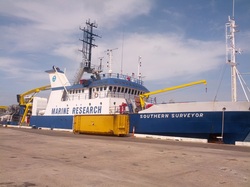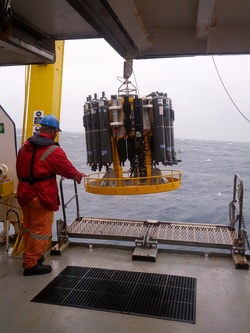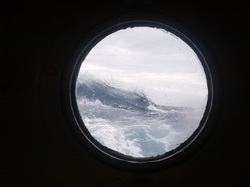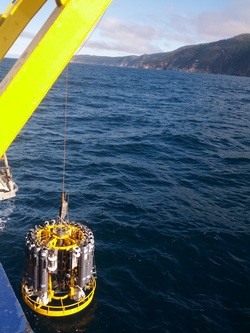
The CSIRO's Southern Surveyor
In a deviation from the floating houses, Cambodia and generally tropical research areas I’ve begun a Masters in Marine and Antarctic Science at UTAS. A girls gotta do what a girls gotta do right?
The year’s got off to an awesome start from two points, firstly we got to go on a ship.. and that was a subject.. secondly there’s a refreshing focus on Science Communication leaking through many of the lectures and assessment pieces. It’s actually pretty exciting to watch as it becomes integrated into the learning of science at UTAS. Does that happen at UQ? Yeah.. Nah
So as part of the assessment for the ship board subject we had to write daily blogs, which believe you me is no task for the faint of heart, nor stomach, on a moving ship. Few things will reacquaint you so rapidly with your breakfast as trying to read a computer screen. However, we persisted, below are my blog posts from the journey. The rest of the posts from my colleagues can be found at http://shiplogblog.blogspot.com.au/
The year’s got off to an awesome start from two points, firstly we got to go on a ship.. and that was a subject.. secondly there’s a refreshing focus on Science Communication leaking through many of the lectures and assessment pieces. It’s actually pretty exciting to watch as it becomes integrated into the learning of science at UTAS. Does that happen at UQ? Yeah.. Nah
So as part of the assessment for the ship board subject we had to write daily blogs, which believe you me is no task for the faint of heart, nor stomach, on a moving ship. Few things will reacquaint you so rapidly with your breakfast as trying to read a computer screen. However, we persisted, below are my blog posts from the journey. The rest of the posts from my colleagues can be found at http://shiplogblog.blogspot.com.au/

Deploying the CTD
Day 1
At 0800 this morning the Southern Surveyor, complete with her enthusiastic crew of UTAS Masters students, farewelled Sydney and steamed out into the wide ocean. With a pilot at the helm we were given an introduction to the science activities planned for the voyage, shortly followed by a “chefs tour” and safety induction to the ship which resembles in almost all ways a steel rabbit warren (sans rabbits). Despite some pale faces and queasy stomachs the Morning shift tackled the first science sampling station with vigour. We started by prepping the Conductivity Temperature Depth sensor (CTD), which is being used to calibrate a collection of eXpendable Bathy Thermographs (XBT), under the watchful eye of the crew. After a few technological glitches a number of XBT’s were released whilst the CTD made its stately way down to 1000m below sea level.
From the operations room we watched as the temperature readings from the XBT’s that were dropped over the side. The water temperature varied from a balmy 25 degrees at the surface dropping slowly but surely down to a bitter 7 degrees or so around the 900m mark. After the CTD was recovered water samples were taken from canisters to measure attributes such as oxygen, nutrients and chlorophyll. All these measurements are used to develop an understanding of the water column and how that has changed over time.
As the AM group signed off for the day, sea legs a little wobbly but hardening up, the PM shift signed on demonstrating great dedication to science by undertaking testing in the rolling seas from 2am till 4:30am. We’re all looking forward to facing the second day well rested with a full stomach!
At 0800 this morning the Southern Surveyor, complete with her enthusiastic crew of UTAS Masters students, farewelled Sydney and steamed out into the wide ocean. With a pilot at the helm we were given an introduction to the science activities planned for the voyage, shortly followed by a “chefs tour” and safety induction to the ship which resembles in almost all ways a steel rabbit warren (sans rabbits). Despite some pale faces and queasy stomachs the Morning shift tackled the first science sampling station with vigour. We started by prepping the Conductivity Temperature Depth sensor (CTD), which is being used to calibrate a collection of eXpendable Bathy Thermographs (XBT), under the watchful eye of the crew. After a few technological glitches a number of XBT’s were released whilst the CTD made its stately way down to 1000m below sea level.
From the operations room we watched as the temperature readings from the XBT’s that were dropped over the side. The water temperature varied from a balmy 25 degrees at the surface dropping slowly but surely down to a bitter 7 degrees or so around the 900m mark. After the CTD was recovered water samples were taken from canisters to measure attributes such as oxygen, nutrients and chlorophyll. All these measurements are used to develop an understanding of the water column and how that has changed over time.
As the AM group signed off for the day, sea legs a little wobbly but hardening up, the PM shift signed on demonstrating great dedication to science by undertaking testing in the rolling seas from 2am till 4:30am. We’re all looking forward to facing the second day well rested with a full stomach!

Swoosh
Day 2
After being rocked into a refreshing sleep by the waves the AM science crew awoke to find that the first planned station of the day had been cancelled due to bad weather. With a spot of time on our hands until the next station we prepared all the scientific equipment and had some spare time to explore the ship and attempt to email home via the somewhat fickle satellite link. In the swell the view from the bridge (where the captain hangs out) was particularly spectacular. With nothing but waves and the occasional albatross it was humbling, although exciting to be adventuring out here.
After being rocked into a refreshing sleep by the waves the AM science crew awoke to find that the first planned station of the day had been cancelled due to bad weather. With a spot of time on our hands until the next station we prepared all the scientific equipment and had some spare time to explore the ship and attempt to email home via the somewhat fickle satellite link. In the swell the view from the bridge (where the captain hangs out) was particularly spectacular. With nothing but waves and the occasional albatross it was humbling, although exciting to be adventuring out here.
How one could think of shooting the albatross (ala The Rime of the Ancient Mariner) eludes me, even some few kilometres off the coast the creatures that survive
Around lunch time the weather and waves had chilled out enough to start the next station. The AM shift got right into it and ran successful drops and tests in record time. Sadly the weather then picked up and all future research stations have been put on hold. This was probably a reasonable experience of genuine scientific research, no matter how well planned a project something will still go wrong. The tasks left for the day involved significant periods of time looking down a microscope at various plankton forms captured from the water column, however it must be noted that looking down a microscope on a moving ship is not for the faint hearted, nor those whose sea legs may have wandered off.

Deploying the CTD near Maria Island
Day 3
0600 AM shift woke to the rather fervent rolling of the Southern Surveyor in the southern seas. Due to the high seas the ship was running behind schedule so science had to take a backseat for the morning while captain made valiant efforts to catch up time. Many of our crew were feeling a little under the weather with the more enthusiastic rocking of the boat however we managed to undertake some chlorophyll sampling in the morning hours. With the ship ploughing through the waves we managed to gain enough time to undertake a sampling station after lunch. In an effort to expedite matters the AM shift joined forces with the PM shift to make the sampling as smooth as possible. From down in the operations room this appeared to be very effective (although it’s amazing how quickly time can fly by when you don’t have to stand on the back of a ship in the rain, where true oceanography is done).It’s looking like we will have dropped enough small temperature sensors (XBT’s) to calibrate this year’s batch which will be invaluable in the use of these data sets in ocean temperature and climate research. Although there’s been a few hiccups in this research mission its fantastic to be undertaking scientific activities on this boat that will help inform much larger global datasets!
0600 AM shift woke to the rather fervent rolling of the Southern Surveyor in the southern seas. Due to the high seas the ship was running behind schedule so science had to take a backseat for the morning while captain made valiant efforts to catch up time. Many of our crew were feeling a little under the weather with the more enthusiastic rocking of the boat however we managed to undertake some chlorophyll sampling in the morning hours. With the ship ploughing through the waves we managed to gain enough time to undertake a sampling station after lunch. In an effort to expedite matters the AM shift joined forces with the PM shift to make the sampling as smooth as possible. From down in the operations room this appeared to be very effective (although it’s amazing how quickly time can fly by when you don’t have to stand on the back of a ship in the rain, where true oceanography is done).It’s looking like we will have dropped enough small temperature sensors (XBT’s) to calibrate this year’s batch which will be invaluable in the use of these data sets in ocean temperature and climate research. Although there’s been a few hiccups in this research mission its fantastic to be undertaking scientific activities on this boat that will help inform much larger global datasets!

Dolphins!
Day 4
Bright and early the AM group prepared for their final full station taking the opportunity to demonstrate slick scientific skills. By now we are pretty good at it, although we did run into a few problems with data reading from the XBT’s, the challenge of relying on a thin copper wire to transmit temperature information from the deeps. I have my suspicions that the wire may have had a rather intimate meeting with the ships propeller.. *blush* doesn't really cover it.
The water temperature has notably changed from near Sydney, with the surface dropping to around 20 degrees, although the water around 900m remains in the vicinity of 7 or 8 degrees. Today we also had the opportunity to learn some more about the mapping equipment on board including echo-sounders and swath mappers which provide users with highly detailed information about the sea floor. As a geo-geek I was particularly enthusiastic.
Today was particularly exciting for two reasons, the scientific excitement was undertaking a sampling transect out from Maria Island. The Island was beautiful (and it wasn’t just because it was the first land we had seen in days) and it was quite different to be working in water only 40m deep, down from the 4km earlier in the week. It was also exciting as the boat attracted a mindbogglingly big pod of dolphins. We were also graced by the presence of seals off in the distance and an array of sea birds, including some elegant albatrosses. The wonder of seeing so much nature up close seemed to surprise the residue sea sickness out of everyone, filling them with vigour for what turned out to be a long night of research and sampling.
Bright and early the AM group prepared for their final full station taking the opportunity to demonstrate slick scientific skills. By now we are pretty good at it, although we did run into a few problems with data reading from the XBT’s, the challenge of relying on a thin copper wire to transmit temperature information from the deeps. I have my suspicions that the wire may have had a rather intimate meeting with the ships propeller.. *blush* doesn't really cover it.
The water temperature has notably changed from near Sydney, with the surface dropping to around 20 degrees, although the water around 900m remains in the vicinity of 7 or 8 degrees. Today we also had the opportunity to learn some more about the mapping equipment on board including echo-sounders and swath mappers which provide users with highly detailed information about the sea floor. As a geo-geek I was particularly enthusiastic.
Today was particularly exciting for two reasons, the scientific excitement was undertaking a sampling transect out from Maria Island. The Island was beautiful (and it wasn’t just because it was the first land we had seen in days) and it was quite different to be working in water only 40m deep, down from the 4km earlier in the week. It was also exciting as the boat attracted a mindbogglingly big pod of dolphins. We were also graced by the presence of seals off in the distance and an array of sea birds, including some elegant albatrosses. The wonder of seeing so much nature up close seemed to surprise the residue sea sickness out of everyone, filling them with vigour for what turned out to be a long night of research and sampling.
 RSS Feed
RSS Feed
